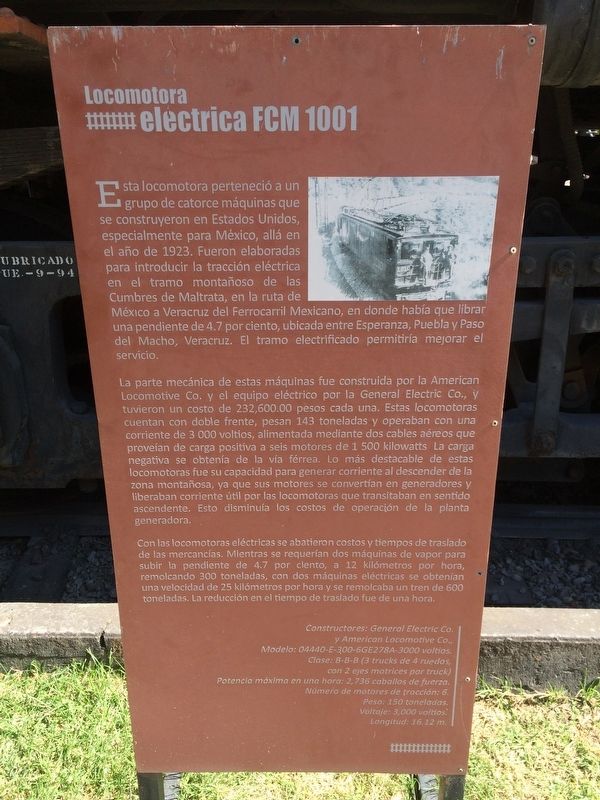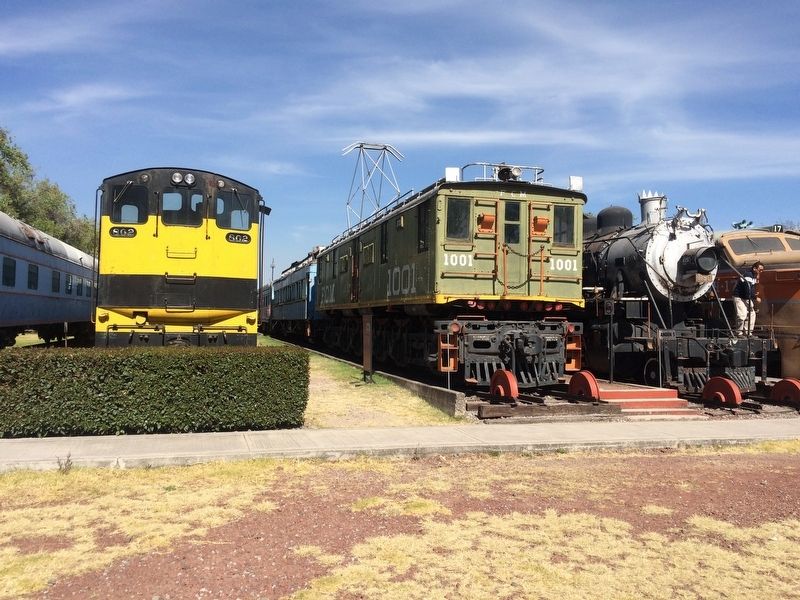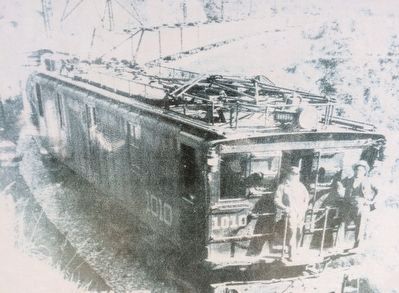Puebla, Mexico — The Central Highlands (North America)
Electric Locomotive FCM 1001
Locomotora electrica FCM 1001
Esta locomotora perteneció a un grupo de catorce máquinas que se construyeron en Estados Unidos, especialmente para México, allá en el año de 1923. Fueron elaboradas para introducir la tracción eléctrica en el tramo montañoso de las Cumbres de Maltrata, en la ruta de México a Veracruz del Ferrocarril Mexicano, en donde había que librar una pendiente de 4.7 por ciento, ubicada entre Esperanza, Puebla y Paso del Macho, Veracruz. El tramo electrificado permitiría mejorar el servicio.
La parte mecánica de estas máquinas fue construida por la American Locomotive Co. y el equipo eléctrico por la General Electric Co., y tuvieron un costo de 232,600.00 pesos cada una. Estas locomotoras cuentan con doble frente, pesan 143 toneladas y operaban con una corriente de 3,000 voltios, alimentada mediante dos cables aéreos que proveían de carga positiva a seis motores de 1,500 kilowatts. La carga negativa se obtenía de la vía férrea. Lo más destacable de estas locomotoras fue su capacidad para generar corriente al descender de la zona montañosa, ya que sus motores se convertían en generadores y liberaban corriente útil por las locomotoras que transitaban en sentido ascendente. Esto disminuía los costos de operación de la planta generadora.
Con las locomotoras eléctricas se abatieron costos y tiempos de traslado de las mercancías. Mientras se requerían dos máquinas de vapor para subir la pendiente de 4.7 por ciento, a 12 kilómetros por hora, remolcando 300 toneladas, con dos máquinas eléctricas se obtenían una velocidad de 25 kilómetros por hora y se remolcaba un tren de 600 toneladas. La reducción en el tiempo de traslado fue de una hora.
Constructores: General Electric Co. y American Locomotive Co.,
Modelo: 04440-E-300-6GE278A-3000 voltios.
Clase: B-B-B (3 trucks de 4 ruedas con 2 ejes motrices por truck)
Potencia máxima en una hora: 2,736 caballos de fuerza.
Número de motores de tracción: 6.
Peso: 150 toneladas.
Voltaje: 3,000 voltios.
Longitud: 16.12 m.
English translation:
Electric Locomotive FCM 1001
This locomotive belonged to a group of fourteen machines that were built in the United States especially for Mexico, back in the year 1923. They were developed to introduce electric traction in the mountainous stretch of the Cumbres de Maltrata, on the route from Mexico to Veracruz on the Mexican Railroad, where a slope of 4.7 percent had to be managed, located between Esperanza, Puebla and Paso del Macho, Veracruz. The electrified section would improve the service.
The mechanical part of these machines was built by the American Locomotive Co. and the electrical equipment
by the General Electric Co., and they had a cost of 232,600.00 pesos each. These locomotives have double fronts, weigh 143 tons and operated with a current of 3,000 volts, powered by two overhead cables that provided positive charge to six 1,500 kilowatt engines. The negative charge was obtained from the track. The most remarkable thing about these locomotives was their capacity to generate current when descending from the mountainous area, since their engines became generators and released useful current for the locomotives that were climbing the grade. This decreased the operating costs of the electrical generation plant.
With the electric locomotives costs and times of transfer of goods were reduced. While two steam engines were required to climb the gradient of 4.7 percent at 12 kilometers per hour, towing 300 tons, with two electric machines, a speed of 25 kilometers per hour was obtained and a 600-ton train was towed. The reduction in the transfer time was one hour.
Builders: General Electric Co. and American Locomotive Co.,
Model: 04440-E-300-6GE278A-3000 volts.
Class: B-B-B (3 4-wheel trucks with 2 drive axles per truck)
Maximum power in one hour: 2,736 horsepower
Number of traction motors: 6
Weight: 150 tons
Voltage: 3,000 volts
Length: 16.12 m
Topics. This historical marker is listed in these topic lists: Industry & Commerce
• Roads & Vehicles.
Location. 19° 3.185′ N, 98° 12.268′ W. Marker is in Puebla. Marker can be reached from Calle 11 Norte just south of Avenida 14 Poniente, on the right when traveling south. The marker is on the grounds of the Mexican National Railroad Museum, to the south of the fifth row of engines and cars after the entrance. Touch for map. Marker is in this post office area: Puebla 72090, Mexico. Touch for directions.
Other nearby markers. At least 8 other markers are within walking distance of this marker. Diesel-Electric Locomotives DH-19 and DH-17 (a few steps from this marker); From Steam to Diesel (a few steps from this marker); Mail Car NM 2555 (within shouting distance of this marker); Nationalization of the Railroads of Mexico - 1937 (within shouting distance of this marker); A National Railroad Network (within shouting distance of this marker); Steam Locomotive NM-601 (within shouting distance of this marker); Engine 601 (within shouting distance of this marker); The Hero of Nacozari (within shouting distance of this marker). Touch for a list and map of all markers in Puebla.
Credits. This page was last revised on December 15, 2017. It was originally submitted on December 15, 2017, by J. Makali Bruton of Accra, Ghana. This page has been viewed 287 times since then and 33 times this year. Photos: 1, 2, 3. submitted on December 15, 2017, by J. Makali Bruton of Accra, Ghana.


